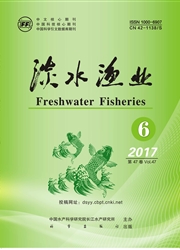

 中文摘要:
中文摘要:
在(21±1)℃的水温条件下,以50mg/kg的单剂量,分别给奥尼罗非鱼(Oreochromis aureus×O.niloticus)水剂口灌和混饲口灌土霉素,用高效液相色谱法(HPLC)检测给药后各个时间点的血药浓度。结果显示:最低检测限为0.005μg/mL,线性范围为0.005~4μg/mL。水剂口灌组和混饲口灌组的药时数据均符合具时滞的二室开放动力学模型,水剂口灌组的动力学方程为:Ct=0.231e^-0.028(t-0.010)+0.353e^-0.011(t-0.010)-0.584e^-0.468(t-0.010),混饲口灌组动力学方程:Ct=0.839e^-0.057(t-0.459)+0.442e^-0.013(t-0.459)-1.281e^-0.282(t-0.459)。水剂口灌组及混饲口灌组主要药动学参数分别为:吸收半衰期(t1/2ka)为1.481h,2.458h;分布半衰期(t1/2a)为24.834h,12.193h;消除半衰期(t1/2β)为60.312h,51.533h;达峰时间(Tmax)为7.230h,8.221h;最大血药浓度(Cmax)为0.494μg/mL,0.796μg/mL;血药浓度-时间曲线下面积(AUC)=37.74μg·h/mL,43.075μg·h/mL。这些参数表明,水剂口灌比混饲口灌吸收快,分布和消除慢,在血液中达到峰浓度的时间更短,但峰浓度值比混饲口灌低。
 英文摘要:
英文摘要:
Hybrid tilapia( Oreochromis aureus × O. niloticus ) was treated orally with either oxytetracycline ( OTC ) aqueous solution or its medicated feed in a single dose of 50 mg/kg body weight at water temperature of(21 ±1 )℃. The OTC concentrations of hybrid tilapia plasma were determined by high performance liquid chromatography( HPLC ). The results were as follows : the detection limit was 0. 005 μg/mL, linear range was 0. 005 - 4 μg/mL. Pharmacokinetic data of the hybrid tilapia plasma conformed to a two-compartment model with first-order absorption in either aqueous solution or medicated feed administration. The pharmacokinetic equation, Ct=0.231e^-0.028(t-0.010)+0.353e^-0.011(t-0.010)-0.584e^-0.468(t-0.010), was for aqueous solution, and Ct=0.839e^-0.057(t-0.459)+0.442e^-0.013(t-0.459)-1.281e^-0.282(t-0.459). for medicated feed. The main pharmacokinetic parameters of the two oral administrations of OTC were respectively as follows : absorption half - life( t1/2ka ) = 1. 481 h for aqueous solution, 2. 458 h for medicated feed, distribution half - life ( t1/2a ) = 24. 834 h, 12. 193 h, elimination half - life (t1/2β) = 60. 312 h, 51. 533 h, Tmax = 7. 230 h, 8. 221 h, Cmax = 0.494 μg/mL, 0. 796 μg/mL, AUC =37. 744 μg · h/mL, 43. 075 μg · h/mL. The parameters showed that the hybrid tilapia absorbed OTC quicker via orally aqueous solution administration than via medicated feed, but the oxytetracycline distributed and eliminated slower through aqueous solution administration than via medicated feed.
 同期刊论文项目
同期刊论文项目
 同项目期刊论文
同项目期刊论文
 期刊信息
期刊信息
